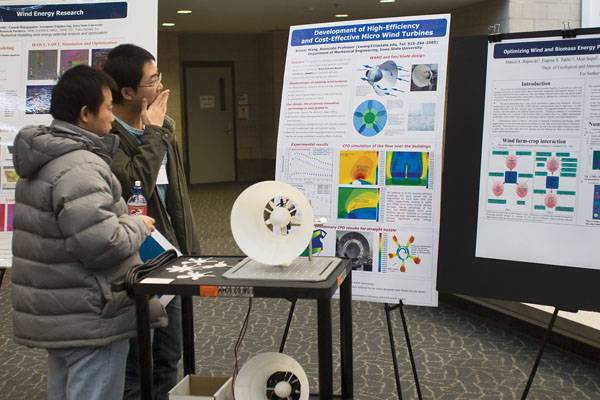Iowa State hosts first wind symposium

Zhihua Wang (left) and Kai Zhang (right) examine a micro wind turbine display on Tuesday, December 9, 2008 at the Wind Symposium at Howe Hall. Iowa State’s first Wind Energy Symposium was held from 7:30 a.m. to 4 p.m. Photo: Gene Pavelko/Iowa State Daily
December 9, 2008
Iowa State hosted its first Wind Symposium on Tuesday, a gathering of minds to discuss the future of the alternative energy and Iowa’s role in this process.
The symposium featured ISU faculty, speakers from government agencies such as the Department of Energy, a CEO from a company manufacturing wind turbines and other wind energy experts.
ISU President Gregory Geoffroy opened the symposium, welcoming both attendees and speakers from around Iowa and the rest of the nation.
“The energy from wind is clean, and in Iowa it’s an almost limitless resource,” Geoffroy said.
A common theme throughout the symposium was not only the environmental side of the movement, but the economic gain to be had.
Megan McCluer, manager of the wind and hydropower technologies program with the energy efficiency and renewable energy office of the U.S. Department of Energy, emphasized the need to start building infrastructure, especially in times of economic uncertainty.
“Everyone is talking about the need for jobs,” McCluer said. “This will create a lot of ‘green collar’ jobs.”
McCluer also said it will serve to keep the money spent on energy here in the states instead of sending our dollars abroad.
“Domestic supply of energy helps our economy by keeping our business here, and helps our national security by taking away reliance on foreign energy,” McCluer said.
Roya Stanley, director of the Iowa Office of Energy Independence, also emphasized that a new, green economy will need all sorts of positions filled, not exclusively manual or specialized labor.
“There are a lot of jobs being created here,” Stanley said. “They start at the design of the service and go all the way through the manufacturing process.”
Several speakers also touched on a plan to have 20 percent of energy in the United States supplied by wind by 2030.
“Right now, wind is 1.5 percent of our total energy; we hope to expand that to 20 percent by 2030,” McCluer said. “We’re already exceeding the expectations at the beginning of the 2030 plan, but we still have a long way to go.”
Joe Jongewaard, wind energy specialist with the Iowa Department of Economic Development, spoke about the research and development alongside manufacturing that would need to occur.
“The development of larger equipment is key to being able to meet our goals,” Jongewaard said.
If the 2030 plan could be achieved, it would greatly reduce the CO2 emissions to the environment, McCluer said. It wouldn’t lower them from current levels, but would slow the rise of emissions.
“The difference between where we’re heading and the 2030 plan is 825 million metric tons of CO2 emissions,” McCluer said.
The speakers were also in agreement that although the 2030 goal could be met, it would take hard work from everyone involved in the process.
“In order for us to achieve these goals it’s going to take a huge, cooperative effort,” Stanley said.






